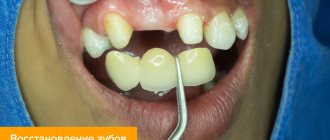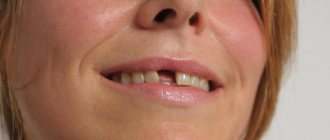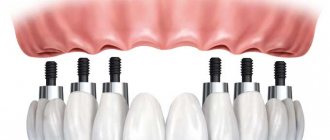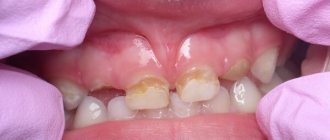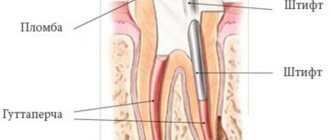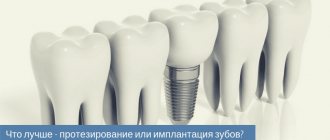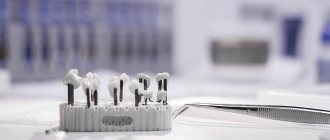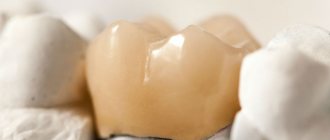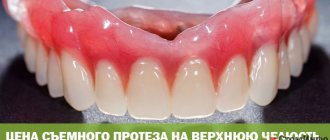- home
- Dental prosthetics
- What to put in place of an extracted tooth? Prosthetics with a missing root
/
/
04/10/2021 05/16/2021 ~3 min
Most people experience tooth loss, sooner or later. The cause may be an injury or one of the “advanced” diseases of the oral cavity and a reluctance to “take care of your teeth.” For example, ignoring simple tooth decay can eventually lead to the need for tooth extraction. Then a natural question arises among potential patients of orthopedists and implantologists: “what can be placed instead of an extracted tooth?” Let's figure it out together with DI and talk about all the options.
Dental prosthetics without grinding
First of all, you need to understand what “prosthetics without turning” means? As you know, when installing a single crown on a partially destroyed tooth, it must first be prepared, that is, processed using a drill and the canals healed. And this is justified due to the need to thoroughly clean the carious cavity, stopping the further development of caries. At the same time, when installing a bridge, healthy teeth are subjected to preparation; moreover, they not only have to be ground down, but also depulped - the nerves are removed from them. Thus, in order to restore one tooth, we “kill” two neighboring ones, because a tooth without a nerve is a dead tooth. It does not participate in the exchange of nutrients, therefore its fragility increases, which, coupled with the increased load that it experiences as a support for the prosthesis, leads to its destruction and loss. This is why grind-free dentures are so popular among both patients and dentists.
Reviews
There are a sufficient number of methods for dental prosthetics. Which one to prefer is decided by the person himself, relying, first of all, on the dentist’s recommendation.
You can share your experience of restoring the integrity of your dentition using one of the methods described above by leaving a comment on this article.
If you find an error, please select a piece of text and press Ctrl+Enter.
Tags: removable dentures
Did you like the article? stay tuned
Previous article
Pitfalls of dental implantation for hepatitis
Next article
Mirell implants - innovative developments in dental prosthetics
Prosthetics of anterior and chewing teeth without turning
Implantation is, of course, the most reliable and durable way to restore lost teeth without any damage to neighboring teeth. The essence of the procedure is to install a titanium pin into the jawbone, followed by prosthetics with a dental crown. The principle of the technique is based on the phenomenon of osseointegration, due to which dental implants completely fuse with the hard tissues of the jaw and become a full replacement of a living tooth in terms of functional and aesthetic parameters. The process itself takes no more than 40 minutes and is carried out under local anesthesia. During the operation, the person does not feel any discomfort, and upon completion of the implantation he is pleasantly surprised by the efficiency. The service life of implants is tens of years; one of the first patients whose teeth were restored using this technique lived with them for 45 years.
When an alternative to dental implants may be needed
Not everyone can get implantation. Contraindications for surgery:
- mental pathologies;
- immunodeficiency states;
- cancer;
- decompensated diabetes mellitus;
- rheumatism;
- problems with blood clotting;
- diseases of the central nervous system;
- diseases of bone tissue;
- inflammatory processes;
- severe heart pathologies;
- renal failure;
- increased sensitivity to antiseptics;
- age up to 18 years.
The list of contraindications varies depending on the implantation method. In addition to the restrictions on installing titanium roots, implantation has other disadvantages:
- relatively high cost of treatment;
- risk of implant rejection;
- the likelihood of damage to the maxillary sinuses (with prosthetics in the upper jaw row);
- complexity of the operation (the integrity of soft, bone tissue, nerve endings and mucous membranes is damaged - postoperative swelling and pain occur).
Bridge without turning
Prosthetics with micro-locks is a relatively new type of restoration of a lost tooth. The method is quite simple: microchannels are created in the walls of the supporting teeth, in which locks are fixed that hold the intermediate part of the bridge. The supporting teeth are not ground down or depulped (nerves are not removed). Due to the design features, bridges with micro-locks can withstand loads that far exceed the maximum possible value of chewing pressure, and the locks optimally distribute the load between the supports, eliminating pressure on the gums. However, the reliability of the system is quite questionable, and is recommended by leading dentists as a temporary structure, for example, during the healing period of an installed implant in the smile area.
What are Lumineers and when are they used?
Lumineers are another type of orthopedic plates designed primarily to correct the color and shape of the tooth surface. The installation of lumineers, unlike veneers, is carried out in one visit and does not involve grinding of the dentition. That is why there is no need to wear temporary structures before installing them. Lumineers also have an undeniable advantage over composite restorations: thin ceramic plates do not darken over time.
However, there are also disadvantages. Since lumineers are installed on an unground surface, it is sometimes very difficult to achieve a tight fit to the teeth. In addition, the tooth on which the lumineer is attached differs from the natural dentition in size and shape, so it is not recommended to correct local defects with its help.
Adhesive technique for restoring teeth without grinding adjacent teeth
This technique involves fixing the prosthesis using various durable and elastic materials, including plastic and fiberglass. Adhesive bridges can be of three types, depending on the type of attachment. The most gentle method is fastening with special glue. The undoubted advantage of such fixation is its reversibility in case of refusal of the prosthesis. The other two types of adhesive bridges still require some processing of adjacent teeth, although less radical than grinding. The fastening is made of fiberglass tape, for which the doctor makes small notches on top or on the back walls of the supporting teeth. It is worth noting that adhesive structures are not reliable and can only be used as a temporary measure and exclusively for the restoration of one tooth. However, this is the most common method of dental prosthetics without grinding, prices for which in various clinics start from 3,000 rubles.
Removable prosthetics without turning
Nylon prosthesis is the fastest and most inexpensive type of removable prosthetics. It is a structure consisting of a frame and an artificial dentition. Thanks to the thinness and flexibility of nylon, the prosthesis fits tightly around the gums and adjacent teeth, adjacent to the edge of the upper or lower palate. Nylon dentures can be used to replace a dental defect of any extent: from one or two teeth to a full jaw. However, it is worth paying attention to the significant disadvantages of this prosthetic option. The elasticity and flexibility of the prosthesis negatively affects the mucous membrane, causing accelerated atrophy and chafing. Due to changes in the topography of the oral cavity and wear of the material over time, nylon dentures require adjustment or replacement. In addition, owners of nylon prostheses experience discomfort when wearing them and are forced to regularly remove the structure for special cleaning and treatment.
The importance of having a complete kit
The absence of a large number of teeth in dentistry is considered a serious pathological condition, entailing the development of many negative consequences, both for the dental system itself and for the entire body.
Some of the most unfavorable and common consequences can be considered:
- Transfer of chewing load to the remaining elements. So, in the absence of molars, grinding of products is carried out with incisors.
In contrast to the lateral teeth, the front teeth have only one root, and their anatomy is not designed for increased chewing load.All this over time leads to the loosening of the frontal elements, their abrasion, the development of traumatic occlusion, cracking of the enamel coating, and the progression of a decrease in the height of the jaw bone.
- Displacement of teeth. Due to the loss of one element, its antagonist (i.e. the tooth from the opposite jaw, which had contact when chewing food) loses support.
This phenomenon is dangerous because of its gradual shift. The same process occurs with neighboring elements. Movement is fraught with improper redistribution of the chewing load, restructuring of the correct bite into an abnormal shape, and a change in the functionality of the joints. - Development of functional disorders. The lack of teeth (especially from the lateral areas of the jaws) leads to a decrease in the height of the lower part of the face, as a result, the depth of overlap of the frontal units increases, and a deep type of bite is formed.
Functional dysfunction is also manifested, expressed in sluggish (difficult) chewing food. There are problems with swallowing and pronunciation. - Jawbone atrophy. After about 4-6 months. from the moment of tooth loss, an atrophic process begins to develop in the bone tissue, i.e. when the alveolar processes become thinner and smaller in size, the jawbone is resorbed.
Its onset is associated with the absence of the previous chewing load. The more time passes after tooth loss, the more pronounced bone atrophy becomes (the process becomes irreversible).Insufficient volume of bone tissue will be an indication for mandatory bone augmentation (plasty) before implantation.
- Change in appearance. Lack of teeth certainly affects a person’s appearance.
So, if several anterior maxillary elements are missing, the upper lip recedes. When molars are missing, the cheeks recede. If there are no antagonistic pairs, the height of the lower part of the face decreases. In addition, age-related changes in appearance appear much faster, i.e. signs of aging appear ahead of time: nasolabial wrinkles appear, the corners of the mouth droop, lips become thinner. - Headache .
A change in the distribution of the chewing load leads to a change in the position of the articular head, which is fraught with the development of inflammation, arthritis or arthrosis in it. If the problem of missing teeth is not eliminated for a long time, deformation of the dentition begins, changes in occlusion, and as a result – regular headaches. - Gastrointestinal dysfunction. Poor chewing of food triggers the occurrence of various pathological conditions in the gastrointestinal tract. These include gastritis, duodenitis, increased acidity in the stomach, gastric or duodenal ulcers.
- Problems with pronunciation. The absence of teeth (especially in the front part of the dentition) always distorts speech.
- Dislocation of the mandibular joint due to thinning and weakening of the gum bone tissue.
Separately, dentists name another consequence of the absence of a large number of teeth, which is a common result of the conditions listed above - the emergence of a psychological complex and a communication disorder due to a person’s dissatisfaction with his appearance.
People who have some problems with the oral cavity usually try not to attract the attention of others, smile rarely and reluctantly, keep their lips closed, and try not to show their teeth. It is logical that they are reluctant to communicate, problems arise with establishing contacts and building simple human relationships.
If for some reason you delay the restoration of teeth, you need to know that such an action increases the likelihood of consequences that in the future may become an obstacle to high-quality and successful implementation of prosthetics.
For which categories of pensioners is dental prosthetics provided free of charge?
Let's look at the types of high-quality and inexpensive dentures here.
This address https://www.vash-dentist.ru/protezirovanie/semnyie-p/kakie-materialyi-zubnyih.html provides useful information about modern materials used for the manufacture of dentures.
Prices for dental prosthetics without turning
As for the cost of dental prosthetics without turning, the price corresponds to the quality. So, the most expensive option would be to install an implant. In Moscow, prices for dental implantation are as follows: together with anesthesia, it will cost approximately 30,000 rubles in an economy class dentistry and 80,000 in a premium clinic. To this amount it is necessary to add the cost of crowns - temporary (if necessary) and permanent: from 700 to 50,000 rubles per piece, depending on the material of manufacture and the price category of the clinic. You will have to spend from 9,000 to 30,000 rubles on an adhesive denture in economy and VIP class clinics. The price for removable nylon dentures ranges from 7,000 rubles to 36,000.
Today, various types of dental prosthetics without grinding have become possible, reviews of which can be found on our portal. But analyzing existing technologies, we can conclude that the only solution that can make you forget about missing teeth for the rest of your life is implantation. After all, only it provides an impeccable aesthetic result and function. Of course, dental implantation has pros and cons that need to be studied before making a final decision on choosing a technique for restoring lost teeth.
Write a comment
Dasha
March 10, 2021 at 08:58 pm
I have two dentures and, strangely enough, I was never faced with the question of choice; the dentist always decided for himself which method was suitable for my situation. I think there is nothing wrong with this, he is much more competent in this matter than me. I had microprosthetics done twice, and I can’t say for sure anything bad. This design looks very natural.
Georgiy
March 11, 2021 at 6:08 am
I have experience with implantation. The fact is that having lived in the north for a long time, due to the climate and local water, I lost many molars, but I put them in the form of bridges. And then something bad happened, I knocked out my front tooth, it’s a shame that it’s healthy. The question arose how to fix the problem. It was then that they offered me a way to install a prosthesis without turning by implantation. They warned about the price, but the advantages of the method decided in its favor. As a result, the neighboring healthy teeth are intact, and I have a beautiful incisor that is no different in appearance from its neighbors. I hope that with the development of the method, the price will decrease somewhat and become more affordable.
Lisa
March 11, 2021 at 09:10 pm
Of course, there are now quite a few options for prosthetics and, fortunately, science does not stand still and moves forward every day, making our lives more comfortable and better. I only have one prosthesis and I am incredibly glad that I live in a time when people invented prosthetics. They diagnosed me this way, the doctor did everything quickly enough, it’s indistinguishable from his own.
Irina
May 11, 2021 at 5:13 pm
I don't have implants yet, but the dentist upset me. With periodontal disease, like mine, the teeth will begin to fall out on their own in adulthood, so I’m already thinking about what type of prosthetics is right for me. I agree with Lisa, science does not stand still, and I hope in the near future prosthetics will improve and prices will not be so high.
Vitalina Igorevna V.
February 11, 2021 at 7:57 am
I like the Butterfly prosthesis, the doctor persuaded me to install a permanent fixed prosthesis, drill holes in the adjacent teeth and insert a crown there. But I didn’t want to, because it would still have a negative effect on my teeth, and they are sensitive to me. I can imagine that it would hurt and it would be impossible to remove it. And there are no problems with the butterfly - I took it off, put it on, nothing hurts.
Arthur
February 11, 2021 at 8:48 am
I recommend an adhesive bridge. There are no problems with him, as many people fear. Set it and forget it. Before this I used nylon, it was not pleasant. I don’t know why people praise this type of design and wear it for years. Firstly, he constantly wanted to fall out, so I always had to use cream under the prosthesis. Secondly, you constantly feel a foreign body in your mouth; eating is stressful. It was rubbing, all the gums were sore.
Nikita
February 11, 2021 at 8:55 am
If the tooth is not completely destroyed, for example, due to an injury it is broken, but not completely, it is better to install a veneer. Only it’s not cosmetic, but it’s so powerful, it’s called medicinal or something like that. Especially on the front teeth. It holds well and is not noticeable from the outside. The only thing is that you can’t bite on it, even soft foods. The dentist strictly forbade it, I don’t want to try it yet, so I didn’t check it personally.
